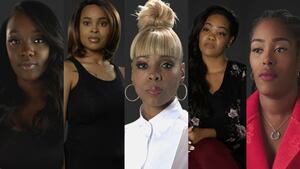Jim DeRogatis’ Soulless: The Case Against R.Kelly is a stunning account of harm done and dismissed.
The new book, set to be released June 4, charts the almost two decades journalist and music critic DeRogatis spent chronicling R. Kelly’s pattern of sexual abuse and predation. Through R. Kelly’s child pornography trial and numerous lawsuits against the R&B singer, as well as conversations with countless survivors, families, and witnesses, DeRogatis has become the foremost expert on the man who he believes to be the greatest predator in the history of the music industry. And his reporting has even earned him a shout-out from R. Kelly himself—in a 2018 single the singer, whose abusive behavior was finally beginning to have a tangible effect on his career and profits, complained that DeRogatis has “been trying to destroy me for twenty-five whole years.”
But while DeRogatis is uniquely qualified to lay out the case against R. Kelly in its entirety, he’s determined throughout the book to center the women and girls who have shared their stories with him.
“During the reporting that led to this book, I learned the names of forty-eight women whose lives R. Kelly has significantly damaged and sometimes destroyed,” DeRogatis writes.
Along with this need to do right by the survivors, DeRogatis takes seriously the responsibility of assigning blame where it is necessary, calling out the societal apathy and systemic failures that allowed R. Kelly to evade consequences for decades. Law enforcement and the legal system are both on the hook, as are R. Kelly team members, artistic collaborators, music critics and fans. In the end, Soulless’s case against complicity is perhaps its most damning, as DeRogatis’ detailed account of the allegations against R. Kelly contains moments where R. Kelly might have been held accountable. The singer’s second indictment, in February 2019, might be seen as a victory for DeRogatis, who spent so many years on a near-solitary journalistic crusade to shed light on Kelly’s crimes. Instead, the critic writes, “I felt only a profound sense of sadness. It was all too little, too late.”
DeRogatis’ work on the R. Kelly story began with an anonymous fax in 2000. The tip, which spoke of the singer’s “young girl” problem, alleged that he was currently “messing with a thirteen-year-old-girl who he tells people is his goddaughter.” DeRogatis and his partner’s reporting quickly led them to the young girl who would years later be at the center of Kelly’s infamous child pornography trial. The fax also pointed them toward the 1996 case of Tiffany Hawkins. Hawkins was represented by Susan E. Loggans, an attorney who, according to DeRogatis, has represented at least six underage R. Kelly victims in cases that often resulted in settlements and non-disclosure agreements.
DeRogatis’ reporting spans a number of phases, bringing to light the stories of women that Kelly allegedly victimized before, during, and after his child pornography trial. Tiffany Hawkins’ story is a natural starting point.
The sexual contact between the 15-year-old Hawkins and a then-24-year-old Kelly allegedly began in 1991. The allegations contained in Hawkins’ lawsuit set the stage for the many claims and stories that would follow, but had somehow managed to fly under the radar for years. “In colorless language belying the drama of the story it told,” DeRogatis begins, “the lawsuit claimed Kelly kicked Tiffany out of the recording studio whenever she didn’t want to have sex, and that she agreed to some of the acts he demanded in the studio and at his homes, including threesomes with other underage girls. The suit also claimed she traveled and had sexual contact with Kelly on his tour bus.” The case was ultimately settled for $250,000. Years later, DeRogatis discovered that Hawkins initially wanted to press charges, but eventually filed her civil claim after “law enforcement declined to act.”
“More than two decades of predatory behavior might have been stopped there, in 1996,” DeRogatis writes. Instead, the chain continued unbroken.
Hawkins performed as a back-up rapper on Aaliyah’s breakout record, Age Ain’t Nothing But A Number. The 14-year-old star in the making had been introduced to R. Kelly by her uncle Barry Hankerson, who was Kelly’s manager at the time. “All but one of my sources said she and Kelly began having sexual contact during her first recording sessions,” DeRogatis reports.
R. Kelly wrote, produced, and titled the 1994 album, and Aaliyah was just 15 when it was released. Shortly after, rumors spread that R. Kelly and Aaliyah had married, confirmed by a Cook County marriage certificate in which the young star was erroneously listed as 18. “Several other sources confirmed she told Kelly she was pregnant, but the legal filings made no mention of that,” DeRogatis continues. “Another source, the only one who ever mentioned this, claimed Kelly had also recorded his sexual contact with Aaliyah, but those tapes had been destroyed.”
Another woman, Lizzette Martinez, told DeRogatis that she met R. Kelly at a Miami mall in 1995, when she was 17 years old. More than three years of sexual contact between her and the singer followed. Martinez recalled an early dinner at the Outback Steakhouse with Kelly and his team to DeRogatis. During the dinner, she said, Hankerson “kept looking at her with fatherly concern.” As DeRogatis notes, “The marriage between Kelly and Hankerson’s niece Aaliyah had been annulled only a few months earlier.”
“‘It was very controlled—what I wore, how I spoke, who my friends were, who I could bring around,’” Martinez told DeRogatis. “Kelly made her call him ‘Daddy,’” he writes. “She had to ask for food ‘like he owned me,’ and he pressured her to perform some sexual acts against her will, including anal play and threesomes with another girl.” Martinez described extensive physical abuse to the reporter. Recalling one incident at a hotel, she said, “Oh, God, he beat the shit out of me that night. Grabbing me, dragging me in the room.”

At one point, DeRogatis writes about the shock of discovering Tracy Sampson’s lawsuit, which alleged sexual contact with the star between 2000 and 2001. “Another affair with an underage girl who could not legally consent, and this one was ongoing even while we were doing the reporting for our first story about Kelly’s predatory pursuits,” he offers.
While Soulless does feature the stories of many women who participated in Surviving R. Kelly, it brings a good deal of new information to the table. Over his years spent covering R. Kelly, DeRogatis has built up an enviable network of sources, and has incomparable insight both into the man himself and the complex system of payouts, NDAs, and co-conspirators he used to insulate himself from censure. In a mere throwaway passage, DeRogatis reveals that “many women who’ve slept with him have told me Kelly is bisexual and has sex with other cis males. They say he keeps these encounters ‘on the down low’ either because of shame or because it conflicts with the image he projects as the consummate ladies’ man.”
Patterns emerge in DeRogatis’ reporting, so repetitive as to blur countless survivors’ stories into one disturbing narrative. Multiple survivors, according to their own statements to DeRogatis and/or legal documents, recall being handed slips of paper by members of R. Kelly’s team with his number. One woman, Patrice Jones, alleged in her lawsuit that, at 17 years old, she was pressured into an abortion by R. Kelly, and even went so far as to flee a clinic only to be dragged back by the singer’s assistant.
It’s hard to over-emphasize the “open secret” aspect of R. Kelly’s behavior. It was well known that R. Kelly’s “favorite restaurant” was Chicago’s Rock ‘n’ Roll McDonald’s, which makes countless appearances throughout Soulless. At one point in his reporting, DeRogatis looked into a 1998 disorderly conduct arrest against R. Kelly (charges were eventually dropped). The basic story was that the singer had caused a disturbance outside of that very same McDonald’s. But as DeRogatis explains, “Cops on the beat near the Rock ‘n’ Roll McDonald’s knew the Youth Division of the Special Investigations Unit was looking at Kelly for sexual encounters with underage girls, and they believed he cried for teens at the garish theme restaurant.”
Patrice Jones’ own R. Kelly story “began at the Rock ‘n’ Roll McDonald’s” in 1998. Jones entered the chain with her cousin, wearing a dress and a corsage—the two were coming from their high school prom. As DeRogatis narrates, a Kelly crew member brought Patrice a napkin with the singer’s phone number on it. “But Patrice’s date didn’t find the encounter nearly as exciting as the rest of the group,” DeRogatis concludes. “He’d heard stories about Kelly’s appetites, and the singer had once tried to pick up his sister.”
Finally, in 2002, R. Kelly faced what would appear to be a fatal reckoning. DeRogatis received a tape that appeared to show a number of sexual acts between R. Kelly and that original 13-year-old girl the tipster had told him about: Reshona Landfair. Her aunt, the singer Stephanie “Sparkle” Edwards, confirmed to DeRogatis that it was Reshona on the tape, and she appeared to be 14 when it was recorded. DeRogatis handed the tape over to authorities, and an indictment against R. Kelly followed.
DeRogatis recalls an alarming gaffe that occurred during a subsequent Chicago Police Department press conference. “At the start of the press conference, an aide from [State’s Attorney] Devine’s office handed a two-page press release and a copy of the twenty-four-page indictment to every reporter. [DeRogatis’s co-reporter Abdon Pallasch] and I couldn’t believe it, but Reshona Landfair’s name had not been redacted.”
Once it was pointed out that the name of an alleged underage victim hadn’t been redacted, an aide was quick to scoop up the packets. Still, DeRogatis adds, “I wondered if that would have happened with the name of a white girl from Lakeview or the North Shore suburbs.”

Soulless offers a wealth of important trial context for the many readers who are likely confounded as to how the R&B star was eventually acquitted. The bulk of the blame seems to fall on Judge Vincent Gaughan, who was adamant that no information of alleged prior incidents (such as the marriage to Aaliyah) that may have established a pattern of behavior be presented to the jury. Furthermore, DeRogatis reports, “Gaughan ruled as inadmissible any evidence or testimony that Reshona; her mother, Valeria; and her father, Greg, worked for Kelly and were on his payroll.”
Shortly after his release on bail, R. Kelly released the single “Heaven, I Need A Hug.” Reshona’s guitarist-father was credited on the track. Vincent Gaughan was also complicit in the six-year delay that preceded the 2008 trial.
Despite the testimony of “bombshell witness” Lisa Van Allen, who stated that R. Kelly ordered her to have multiple threesomes with Reshona (he told her that Landfair was 16, but she would have been 13 or 14 at the time), Kelly eventually went free. No one was happier at the time than Jerhonda Johnson, an R. Kelly superfan who was a constant presence at the trial.
Johnson was just 15 when she used a fake ID to enter the courtroom. Eleven months after the trial, in May 2009, DeRogatis reports, one of R. Kelly’s guys contacted Johnson on social media and invited her to a party at the celebrity’s house. Soon after, during another visit, R. Kelly allegedly initiated sexual contact—Johnson was 16. “I asked him, like, ‘Do you like your girls younger?’” Johnson recalled. “He said, ‘Of course I do because I can train them.’ He said, ‘Older women, they have too much knowledge. When they’re young, I can train them and I can mold them to be who I want them to be.’” Johnson also allegedly introduced a friend of hers, Dominique Gardner, into R. Kelly’s orbit. Gardner would go on to have a relationship with Kelly up until 2018, when she was one of the six women that DeRogatis reported were living with the singer in what many called a “cult.”
Johnson also told DeRogatis about “the trainer,” a woman who claimed that she was longtime friends with Reshona Landfair. Asante McGee corroborated that she was made to watch Kelly have sex with “the trainer.” DeRogatis writes, “The trainer bragged of starting her sexual relationship with Kelly when she was fifteen, and of being friends in high school with Reshona Landfair.” Kitti Jones, another woman who claimed to have had a sexual relationship with Kelly, said that he personally introduced her to Reshona Landfair. “‘I asked him, “How long have you known ‘Shona?’” Jones told me. ‘He said, “I don’t like people asking me my business, but I raised her.”’”
Throughout Soulless, stars like Jay-Z, Ludacris, Lil Wayne, Ciara, Missy Elliott, Kanye, Chance the Rapper, Robin Thicke and Lady Gaga, to name just a few, are justifiably called out for continuing to work with R. Kelly throughout and after his trial. And then there are the journalists who paid little heed to DeRogatis’ early investigations, and the music critics who continued to praise Kelly’s artistic output, contributing to a cultural climate in which the infamous tape was either dismissed, included as a brief asterisk in otherwise flattering write-ups, or played as a punchline. “The most successful and lucrative period of Kelly’s long career came while the charges of making child pornography hung over him,” DeRogatis points out. “Meanwhile, threats real or imagined and a steady stream of cash settlements kept many who knew about his behavior silent. His lawyers racked up untold billable hours, and the judge assigned to the case seemed happy to accommodate them.”

R. Kelly appears at a hearing before Judge Lawrence Flood at Leighton Criminal Court Building in Chicago on May 7, 2019.
E. Jason Wambsgans/GettyOn top of the R. Kelly case itself, there’s a fascinating meta-story here about DeRogatis’ own journalistic efforts. In one particularly illuminating section, he talks about his struggles to publish a story on the most recent phase of R. Kelly’s predation—the so-called “cult” of approximately six women who lived with Kelly and were subject to his strict “rules” and punishments. Sources told DeRogatis that these women faced physical abuse if they misbehaved, and he was contacted by a number of concerned family members. DeRogatis, who began reporting out that story in 2016, reveals that he worked with three separate news organizations “at length,” each of which ultimately failed to publish the report. The first outlet was MTV News, where they encountered “roadblocks” from “the corporate overlords at Viacom Media networks.”
Thankfully, DeRogatis’ story found a home at BuzzFeed News where, he chronicles, it seemed to make far more of an impact than any of his previous reporting on the case.
There are innumerable threads that run through the many stories that DeRogatis has collected over almost two decades. There’s emotional, physical, and sexual abuse, certainly, and patterns of preying on vulnerable young women—particularly young women of color. But there are other haunting themes that DeRogatis masterfully illuminates. Seemingly most disturbing to the reporter himself is R. Kelly’s penchant for targeting women and underage girls with musical aspirations of their own. Parents told DeRogatis time and time again that their daughters wanted to be stars, and specifically yearned to work with R. Kelly. Aaliyah, a template for Kelly’s predation, was also a symbol of success for young women who wanted to be the R&B star’s next protégée. The combined allegations paint a damning picture of a man who turned ambitious young women into brutalized followers, disconnected from family and friends, their silence commanded or bought with NDAs and costly settlements.
DeRogatis ends his book with a conversation with “patient zero” Tiffany Hawkins, in which she tells him that not only does she no longer sing, but she can’t really enjoy music at all anymore. It’s this admission, DeRogatis writes, that ultimately “breaks my fucking heart.”



